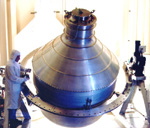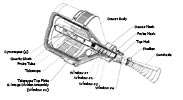STATUS UPDATE AS OF 28 FEBRUARY 2006:
GRAVITY PROBE B MISSION STATUS AT A GLANCE

| Item | Current Status |
| Mission Elapsed Time | 679 days (97.0 weeks/22.3 months) |
IOC Phase |
129 days (4.2 months) |
Science Phase |
352 days (11.6 months) |
Final Calibration Phase |
43 days (1.3 months) |
Extended Science Phase |
4 days |
Post Mission Phase |
151 days (21.6 weeks/5.0 months) |
| Current Orbit # | 10,020 as of 4:00 PM PST |
| Spacecraft General Health | Good |
| Roll Rate | 0.04 rpm (25 minutes per revolution) |
| Gyro Suspension System (GSS) | Gyro #1 digitally suspended; Gyros #2, #3, & #4 in analog suspension |
| Gyro Spin Rates | ~0.52 rpm (nominal spacecraft roll rate before roll down) |
| Dewar Temperature | ~214 kelvin (and rising ~0.7 kelvin/day) |
| Global Positioning System (GPS) lock | Nominal |
| Attitude Control System (ATC) | Nominal for post-mission operation |
| Telescope Readout (TRE) | Pointing performance too low to lock onto guide star |
| Command & Data Handling (CDH) | B-side (backup) computer in control Multi-bit errors (MBE): 0 in CCCA Backup computer; 0 in GSS computer; 1 in SRE computer |
MISSION DIRECTOR'S SUMMARY
On Mission Day 679, the Gravity Probe B spacecraft has completed just over 10,000 orbits and both the vehicle and payload continue to be in good health. All active subsystems, including solar arrays/electrical power, Experiment Control Unit (ECU), flight computer, star trackers, magnetic sensing system (MSS) and magnetic torque rods, gyro suspension system (GSS), and telescope detectors, are performing nominally. We continue to communicate with the spacecraft regularly, monitoring the Dewar and probe as they continue to warm up, and collecting status data from various instruments on-board.


The temperature inside the Dewar has now warmed to ~214 kelvin, and its rate of temperature rise has remains at ~0.7 kelvin per day. The temperature inside the Dewar will eventually reach thermal equilibrium with the temperature of the Dewar's outer shell, but this will occur very gradually, over a long period of time.
Note that at the altitude of GP-B's orbit, 642 km or about 400 miles, the temperature in the upper thermosphere can soar to several thousand degrees centigrade due to solar radiation, but the atmosphere is so thin and the pressure so low at this height--essentially a vacuum--that the temperature of satellites orbiting at this height is a function of the amount of solar and Earth radiation they absorb and not the ambient temperature of the thermosphere. Because the GP-B spacecraft rolls in orbit, the radiation absorbed averages out, and the Dewar shell has been registering a mean temperature that is approximately 240 kelvin (-33 degrees centigrade). Thus, the temperature inside the Dewar will eventually equalize with the average temperature of the Dewar shell.
In last month's update, we noted that the spacecraft is now ready and available for use by other scientists to perform various types of experiments, and we listed a number of such experiments that could be carried out. To this end, we have begun collecting sample data to demonstrate the feasibility and limits of using the GP-B spacecraft to carry out some of these proposed experiments.
Our first set of sample tests is being performed by our telescope group to determine the feasibility of using the two star trackers on-board the spacecraft to observe brightness variations in selected star systems and thereby possibly detect the presence of orbiting planets in those systems. In order to perform this series of tests, we slowed down the spacecraft's roll rate to 0.04 rpm (25 minutes per revolution). The on-board star trackers were then switched into a more sensitive tracking mode, in which the light from stars can be integrated over longer time periods.



For the first of these tests, our telescope team decided to study the star Gamma Cas (HR 264), which is visited by our star tracker B while the vehicle is pointed at our guide star, IM Pegasi. Because the spacecraft's attitude had drifted about 50 degrees southward its orbit plane, we had to re-orient its attitude so that it was once again pointing in the vicinity of IM Pegasi. We accomplished this attitude correction using the spacecraft's magnetic sensing system (MSS) in conjunction with the magnetic torque rods. Our telescope team is now in the process of collecting sample star tracker data on planetary occlusion in the star Gamma Cas.


Throughout the past month, gyros #2, #3, and #4 have remained in analog suspension mode. Now that we have stabilized the spacecraft at a slow roll rate and re-oriented its attitude, we are preparing the commands to remove static charge from all four gyro rotors and then to re-suspend gyros #2, #3, and #4 digitally. Returning all four gyros to digital suspension, will enable us to collect sample data for other post-mission experiments, using the science gyros as 3-axis accelerometers, as described in last month's update.
GP-B MISSION NEWS—GP-B SCIENCE ADVISORY COMMITTEE CONVENES ITS 14th MEETING AT STANFORD
This past Friday and Saturday, 24-25 February 2006, we hosted the 14th meeting of our GP-B Science Advisory Committee (SAC). This committee is external to GP-B and is comprised of seven distinguished scientists, with expertise in various areas of relativistic and gravitational physics, low-temperature physics, and astrophysics/cosmology. Several members of the SAC are associated with other NASA and NSF missions whose results relate to GP-B, including WMAP (Wilkinson Microwave Anisotropy Probe), LIGO (The Laser Interferometer Gravitational-Wave Observatory) and GRACE (Gravity Recovery and Climate Experiment). The committee is chaired by Clifford Will, James S. McDonnell Professor of Physics at Washington University in St. Louis. The purpose of the SAC is to review and advise on all aspects of the GP-B program, including the functioning of the probe and spacecraft, possible sources of error, and the final data analysis.
SAC meeting #14 marks the culmination of the first of three GP-B data analysis phases. In a day-long meeting last Friday, members of the GP-B science team made presentations describing their accomplishments during Phase I and the plans for phases II and III to follow. Phase I focused on short-term, day-by-day analysis of the data, with a goal of honing our data analysis routines and methodologies. One important aspect of Phase I was the division of our science team into two complementary sub-teams, employing slightly different methods to analyze the same data. Representatives of each sub-team explained the differences in their analysis approaches to the advisory committee. The good news was that when preliminary results of both approaches were compared, there was clearly a high correlation between them. Other important Phase I highlights presented to the committee included calibration matching of the telescope and SQUID readout scale factors and the implementation and refinement of a data grading scheme that identifies poor or bad stretches of data tied to spacecraft operating conditions that were not compatible with science data collection. For example, when a computer reboot occurred during the science phase of the mission, the data from that time period should be identified and reviewed for appropriate incorporation into our final data set for the experimental measurement.
On Saturday, SAC members had the opportunity to meet informally with members of our science team and discuss details of the data analysis process in more depth. The SAC meeting officially ended Saturday afternoon, and early this week, GP-B Principal Investigator, Francis Everitt, reported comments by several members of the committee to the effect that SAC #14 was the most valuable meeting yet in terms of both the progress and the clarity of the presentations.
We are now entering Phase II of the data analysis, which will last 4-5 months. During this phase, the team will analyze the data on a month-to-month basis, in order to identify, model, and remove systematic errors that span many days or months, including effects resulting from spacecraft anomalies. Phase II will culminate in another meeting of the SAC committee in mid to late August. At that point, the team will begin Phase III of the analysis, during which additional systematic effects will be removed and the results from all four gyros will be combined. This final phase of the data analysis is expected to be completed towards the end of this year.
A preliminary plan was laid out for a much more extended SAC review process in the Dec 2006-Jan 2007 time frame, which would include a careful and critical review of the complete analysis and results. It is expected that other international experts will participate in the review process. There was some discussion in SAC #14 about the optimum and most objective method of incorporating a blind or double-blind test of the final results, including incorporation of the Harvard-Smithsonian Center for Astrophysics/York University measurements of guide star proper motion. Decisions on these and other end-around tests will be developed with NASA and the SAC as the process moves forward.
Throughout phases II and III, members of our team will also be preparing a number of scientific and engineering papers for publication, and we will also be working with NASA in planning a formal public announcement of the results of this unprecedented test of General Relativity. We currently anticipate announcing the results at a special session during the American Physical Society (APS) meeting in April 2007.
NEXT SCHEDULED GP-B STATUS UPDATE & MISSION NEWS ON 31 MARCH
Our next regularly scheduled update will be at the end of March. Of course, we will post a timely update if there are any important changes in the spacecraft's status, or if noteworthy events occur here at GP-B in the meantime.
UPDATED NASA/GP-B FACT SHEET AVAILABLE FOR DOWNLOADING
We recently updated our NASA Factsheet on the GP-B mission and experiment. You'll now find this 6-page document (Adobe Acrobat PDF format) listed as the last navigation link under "What is GP-B" in the upper left corner of this Web page. You can also click here to download a copy.
Photos & Drawings: The exploded view of the GP-B spacecraft and the orbit position images were created by GP-B Public Affairs Coordinator, Bob Kahn. The drawing and photo of the Dewar and the photos of a star tracker, gyro housing assembly and the Gyro Suspension System (GSS) electronics are from the GP-B Image Archive here at Stanford. The sky chart image, showing the guide star IM Pegasi and Gamma Cas, were generated by the Voyager III Sky Simulator from Carina Software. Click on the thumbnails to view these images at full size.
MORE LINKS ON RECENT TOPICS
- Track the satellite in the sky
- Photo, video & and news links
- Build a paper model of the GP-B Spacecraft
- Following the mission online
- Our mailing list—receive the weekly highlights via email
- The GP-B Launch Companion in Adobe Acrobat PDF format. Please note: this file is 1.6 MB, so it may take awhile to download if you have a slow Internet connection.
Previous Update
Index of Updates
